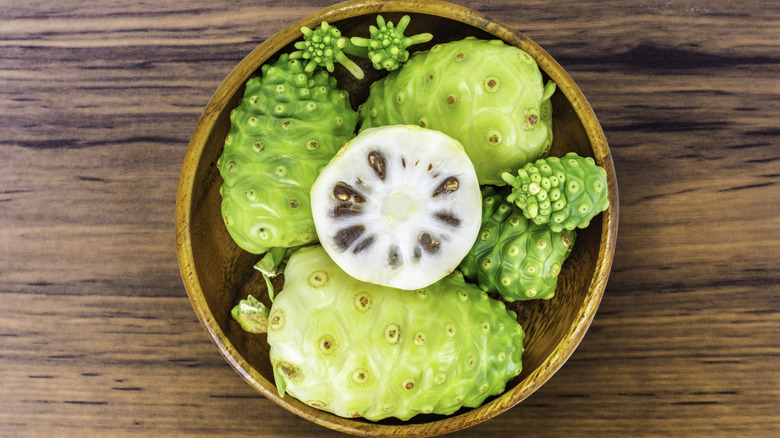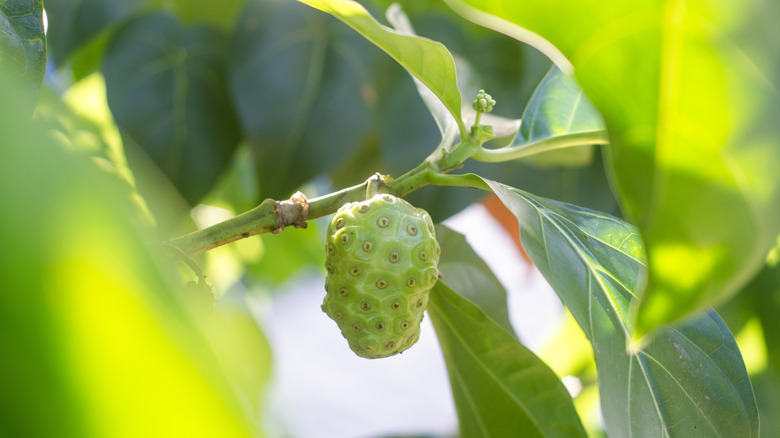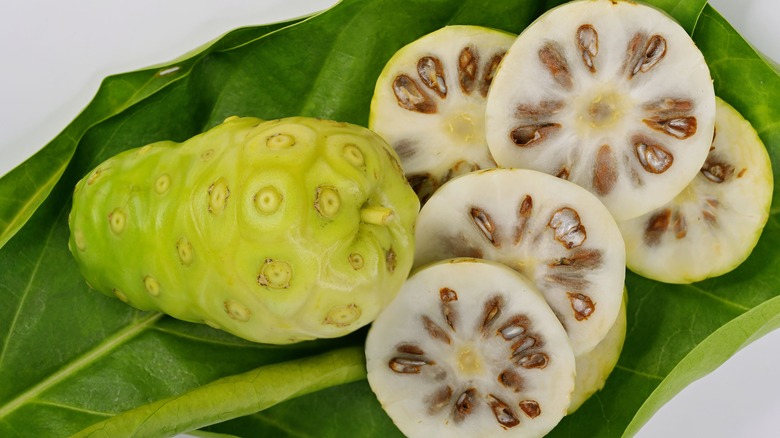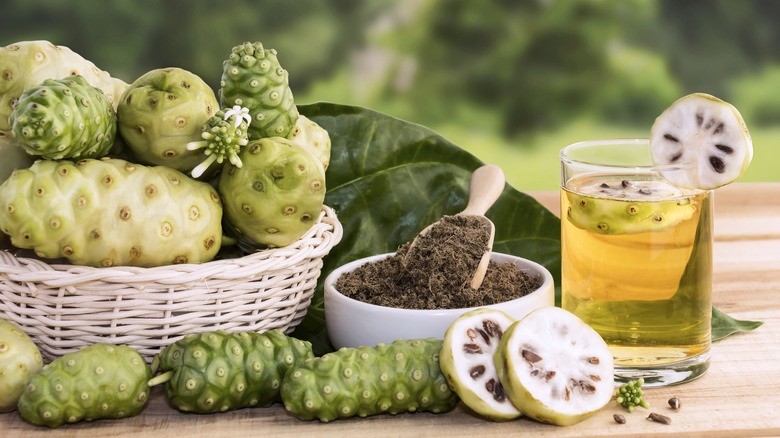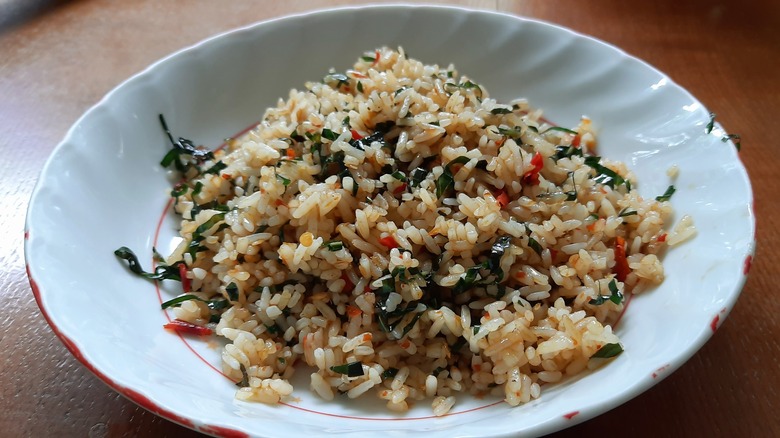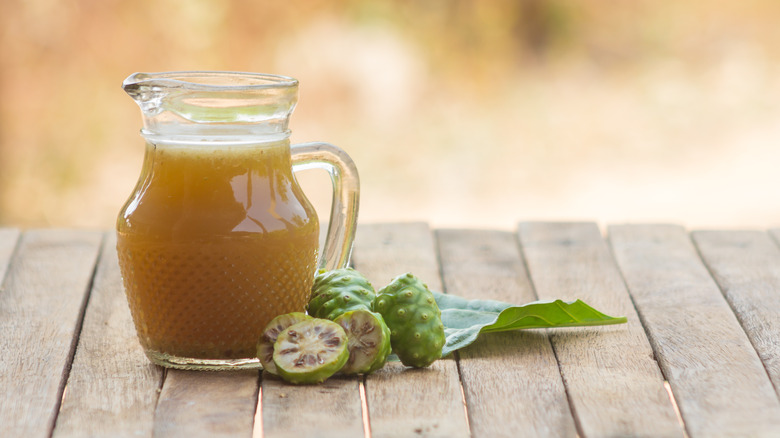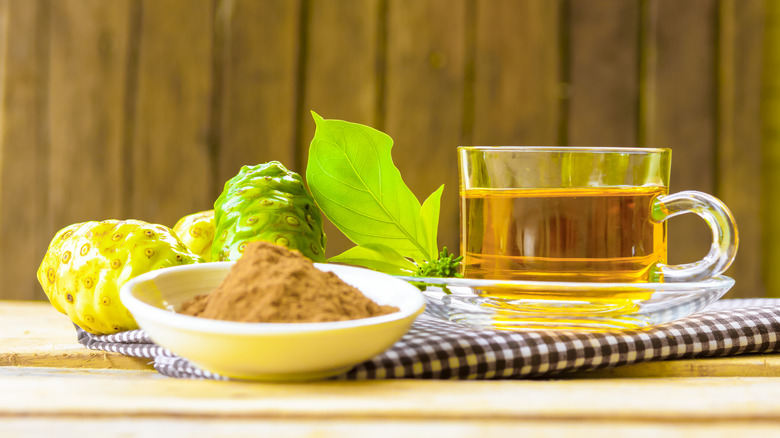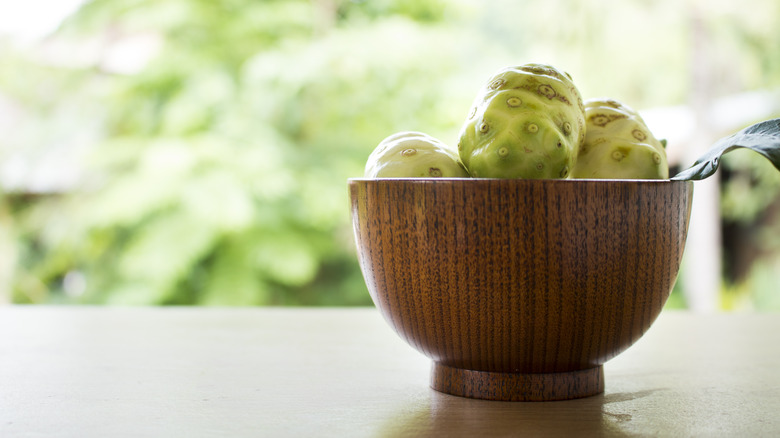What Is Noni Fruit, And What Does It Taste Like?
While the precise origins of the noni fruit are unknown, these hardy plants spread from the islands in and around New Guinea to Hawaii and beyond, along with Polynesians. Their popularity as a natural dye, a medicinal tonic, and a source of nutrition during famine made them an invaluable resource to these explorers of Austronesian descent. Today they can be discovered growing in the most inhospitable environments ranging from cliffsides to coral keys to areas ravaged by lava flows.
Despite this lengthy history, noni did not become globally recognized until the 1980s, when rumblings of its purported health benefits began to be more widely researched. Since then, it has developed a bit of a cult-like following, enjoying immense popularity among those in health food circles in myriad forms, from powders to leathers to juices.
How did a fruit that has been dubbed "starvation fruit" and is known for its fetid stench reminiscent of "cheese" and "vomit" become the darling of the naturopathic movement? And how does one get past the aroma to consume it? Let us take a closer look into what noni fruit is, what it tastes like, and how best to use it.
What is noni?
Noni, or Morinda citrifolia, is a pantropical fruit given over 100 unique monikers as diverse as the regions where it grows. This plant, an evergreen tree, is a member of the Rubiaceae family. This family of plants has over 13,500 species, including the Coffea plant, which is responsible for one of the most traded commodities in the world, namely coffee.
These trees can grow 9 to 30 feet tall and are known for being one of the few that bear a fruit that flowers rather than blossoming first and then yielding fruit. Each noni fruit can produce 50 to 75 tiny white daisy-like flowers, which grow from dark spots surrounding the unripened green fruit.
Once these flowers drop, the fruit ripens, becoming darker in color and developing its characteristic odor often described as a combination of cheese, horseradish, fish, and rotting plant matter. Because of this aroma, you will not often find ripe fruit for sale in grocery stores, though unripened fruit may be available.
Due to the capacity of this plant to grow just about anywhere, Polynesian people began viewing it as supernatural, a direct connection to the gods. It was most commonly associated with Pele, the volcano goddess, linking the fruit's acrid flavor to the temperamental nature of this deity.
What does noni look like?
One of the best descriptions of noni we encountered was likening it to a micro pineapple without sharp scales. These fruits range from 2 to 10 inches long and 3 to 4 inches in diameter. Their shape is somewhat spherical, with petite brownish pockmarks punctuating their verdant skin.
As the fruit ripens, its exterior begins to yield from being dense to developing a juicy texture like a tomato and a custard-like hue. The interior of the fruit is peppered with small edible mahogany seed pods. In its ripened iteration, the fruit almost resembles a potato with eyes all over it.
Though noni is often confused with soursop or corossol because they look somewhat similar, they are very different in flavor and use. And obviously, you will note that Soursop does not have the aggressive odor that noni is infamous for.
The leaves of the noni plant, which are also edible, are wide, flat, and deep green in color. They tend to be 7 to 15 inches long and 3 to 10 inches wide, having shiny skins lined with featherlike veins. Though these leaves can have a strong ammoniated aroma redolent of urine or cleaning products, it is nowhere near as offensive as the scent of the noni fruit.
What does noni taste like?
Based strictly on the description of what noni fruit and leaves smell like, you may wonder why on earth you'd want to put it anywhere near your mouth. Yet they are perfectly edible if you can separate the aroma from the flavor, depending upon what stage of ripeness you find them in.
Unripe noni can be quite astringent and has a slightly earthy aftertaste. The noni leaves have a similar bitter flavor which can be an acquired taste, if not somewhat less acrid than its fruit counterpart, making it less offensive. You may notice that the tannic nature of unripe noni will leave your lips and tongue puckering and make them slightly prickly, similar to other tropical fruits like kiwi, mango, and even pineapple.
As noni becomes riper, it tends to become less harsh, yielding a citrus undertone embedded in the custardy flesh of the fruit, which puts off a fermented flavor similar to a pungent blue cheese. The seeds of the noni are edible but slightly sour, benefitting from a light roast before consumption. And beware of overripe noni, which can quickly become overwhelmingly strong, more akin to Limburger cheese.
How to cook with noni
Perhaps the most common way to consume noni fruit is in juice form. Many commercially produced juice products are available, or you can make your own. That said, noni is perfectly edible as long as you know how to use it. The leaves are often treated like an herb in cooking. Once they are removed from their stems, they are julienned and added with coconut milk and spices. They are also used the same way you would use banana leaves as a wrapper for fish or other savory items before baking or steaming them.
Unripened noni is generally too tough to consume as is but can be peeled and then sliced or diced to add to a stir-fry or curry. It can also be blended together in sauces or dressings for a hint of bitterness. Non is also a great addition in raw salads, like a green papaya salad, or sliced thinly and sprinkled with salt as a snack.
Ripe noni can be prepared in a couple of different ways. Its rich texture lends itself to thickening smoothies or sauces. To help mute its aroma, try incorporating tropical fruits like bananas, mangoes, passion fruit, and pineapple and adding seasonings like cinnamon, cloves, allspice, and Li Hing Powder. It can also be mixed into quickbreads, like banana bread, to add richness and a hint of umami-flavor.
Nutritional information of noni
Noni has experienced somewhat of a renaissance because of its purported health benefits. According to Healthline, it has been utilized by indigenous Polynesian cultures for over 2,000 years to treat everything from constipation and infections to pain and arthritis inflammation.
Noni juice has been extensively researched, yielding mixed but promising results. It is high in Vitamin C, biotin, and folate, which are essential for immunity, skin health, and more. This fruit has shown particular benefits to those who smoke — its high levels of antioxidants are linked with minimizing oxidative stress, which can lead to several diseases, including heart disease and diabetes.
Clinical trials also found that it reduced the number of cancer-causing chemicals in those who smoke by 45%, according to Healthline. It may also help reduce cholesterol, bolster physical endurance, strengthen the immune system, and manage pain from arthritis.
Despite these promising medicinal qualities, some should avoid noni. Verywell Fit reports that anyone with liver disease should avoid it due to its hepatotoxic, or liver damaging, potential conferred by anthraquinones in the plant. It is also high in potassium which may be dangerous for those with kidney disease.
And finally, it is contraindicated for those on blood thinners, pregnant or nursing mothers, children, and those undergoing chemotherapy or radiation therapy. The bottom line: Though there may be great potential in incorporating noni into your daily routine, check with your medical professional before embarking on any supplementation regimen.
Where to buy noni
Although you will likely only find fresh noni fruit in Asian markets or specialty stores, the internet is overflowing with different outlets to obtain virtually any type of noni product, including fruit, leathers, juice, powders, supplements, and more. Fresh noni is available in small and large boxes from Florida, although they cannot ship to California.
Noni leather, similar to a fruit roll-up, can be found in plain and banana flavors. To incorporate noni into your daily cup of tea, buy honey harvested from hives planted on a certified organic noni farm. Powders are a simple resource for blending into your smoothies or sprinkling atop an overnight breakfast bowl. You could even add a pinch to your baked goods to accentuate flavor and boost nutritional value.
But perhaps the most widely available noni products are juices of all kinds. You can get pure noni juice, shots, or juice blends supplemented with other berries to offset the aggressive flavor. Just beware of some more processed noni juices, as they may be high in sugar.
You may want to read the labels carefully before purchasing. To add noni to your diet, there is no shortage of resources to obtain it. And if you prefer not to eat it, try a cream, lotion, soap, or even lipstick made of noni. The sky's the limit.
How to store noni
If you succeed in scoring fresh noni fruit, you will want to handle it delicately. Unripened noni can be stored like other fruits in a cool, arid place away from direct sunlight. Once these ripen, which will occur within just a couple of days, you will want to consume the fruit within a day or so. If you cannot eat the whole noni, use caution with storing it, as its pungent aroma will permeate anything around it.
Though you can place uneaten noni in an airtight container in the refrigerator, it won't last more than a day, and you may ruin everything else being stored there. It is safer to package these leftovers in a Tupperware or Ziploc bag and put them in the freezer. Frozen noni will last approximately three months if properly sealed and stored — place it toward the back of your freezer to minimize temperature fluctuations.
Noni juice can be stored for two to three weeks or as long as the expiration date on the container indicates. Because noni juice is so acidic, it is highly recommended not to store it in a plastic jug. Noni juice is also very susceptible to light and should be placed in a nontransparent container. A ceramic jar with a tightly sealed rubber gasket is ideal for storing your noni juice for maximum safety and quality.
